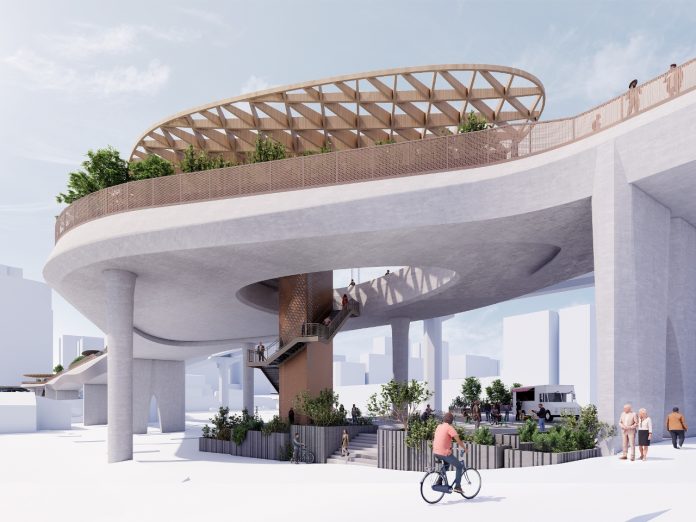
The City of Bellevue is approaching 30% design on a planned pedestrian and bicycle bridge that will connect Downtown Bellevue with the Wilburton neighborhood and Eastrail over Interstate 405. When built, it will create grade-separated access to light rail while at the same time trying to provide a new destination in-and-of-itself between two fast-growing neighborhoods.
The bridge is one of the most important elements of the Grand Connection, a pedestrian corridor intended to stretch from Bellevue’s Meydenbauer Bay Park on Lake Washington to the Wilburton light rail station. Ultimately, that vision calls for a larger highway lid over I-405 to reconnect the city, complementing the pedestrian bridge.
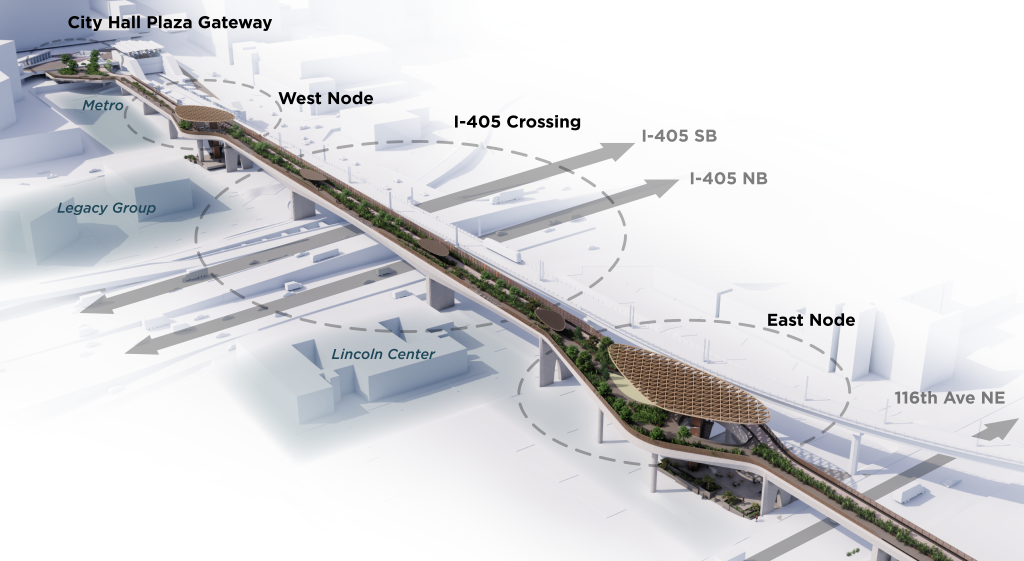
After completing a type, size, and location study, Bellevue has narrowed in on a design for a bridge that is 30 feet wide at Bellevue City Hall plaza and widens out to around 40 feet over I-405. Two “nodes” on either side of the bridge will be even wider, providing space for seating and other amenities, including potential elevators. The renderings released this month show the bridge with separate biking and walking/rolling areas separated by planters, the design of which is pretty similar to the ones bordering the new bike path along the Seattle waterfront, set to open by the end of this year.
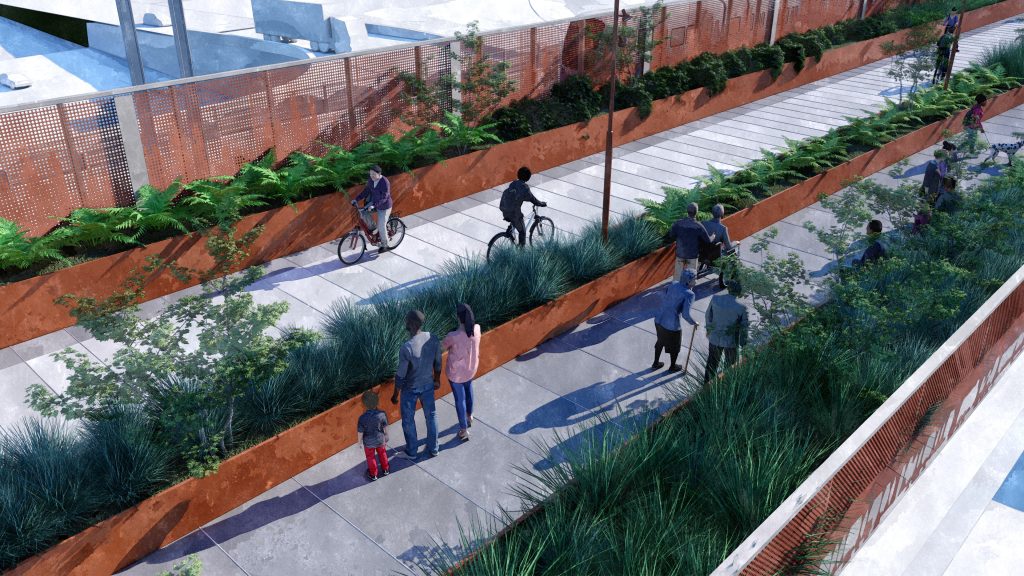
A survey active through October 30 asks respondents what uses they want the new bridge to accommodate, from picnicking to visiting a playground. Integrating placemaking into a new multimodal connections makes sense, but it’s not clear how many people will want to spend a significant amount of time outside so close to the highway.
Bellevue has been able to advance project planning thanks to a matching gift from Amazon in late 2022, and the city’s budget for 2025 includes an additional $15 million to conduct design and engineering work. However, the full cost for the project isn’t yet known, and Bellevue staff are considering ways to phase the project over time and utilize outside funding to get to the finish line.
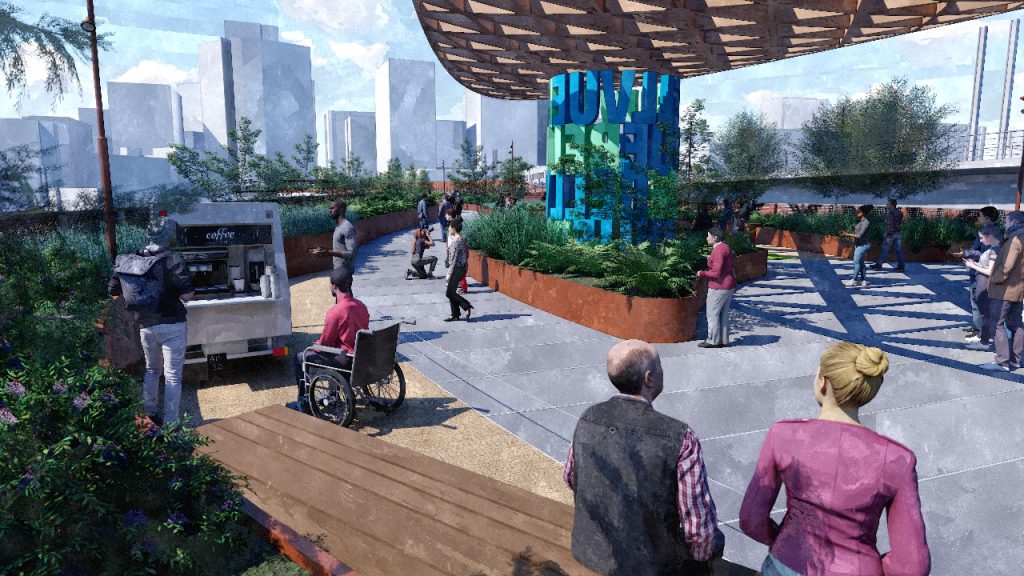
The city is also is also intending to leverage two city-owned properties directly along the route, integrating them into the bridge: a small property formerly belonging to King County Metro near City Hall, currently used as a pop-up dog park, and a larger Lincoln Center property on the east side of the highway. Housing is on the table for either site, but the Lincoln Center property will likely see broader community uses, such as open space or an arts and culture venue.
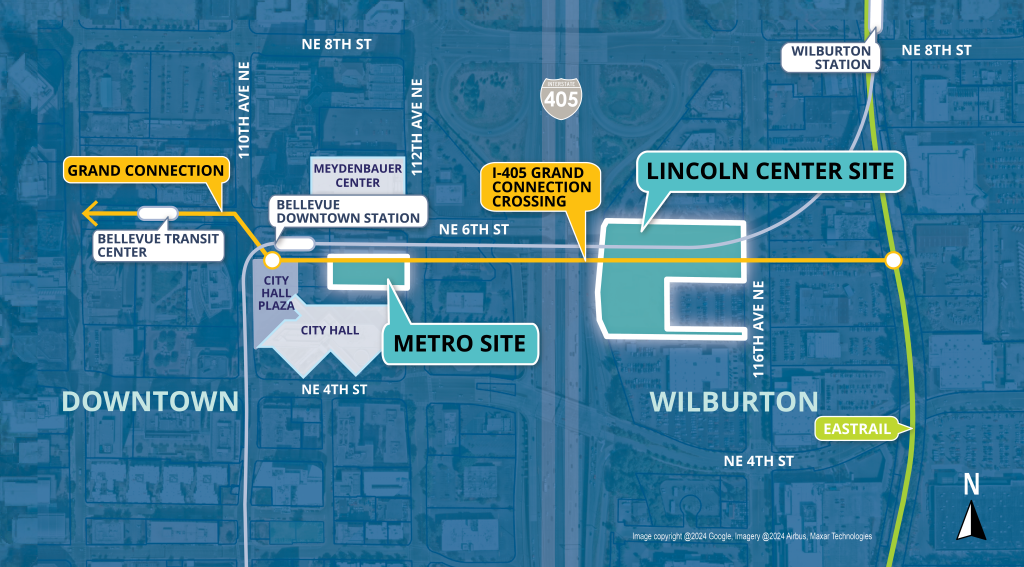
“The Crossing really is an opportunity to connect two exciting parts of Bellevue together to a larger district or neighborhood,” Jesse Canedo, Bellevue’s chief economic development officer, told the City Council last week. “So we will be thinking about the opportunities for different civic uses, potentially on the ground floors or the podiums of buildings, floors one through four, stacked with housing, office, retail and other activities and uses that help push Bellevue’s economy forward for the next 20 years.”
The staff report from last week’s meeting indicated that the bridge design could evolve as Bellevue more fully develops its vision for the adjacent spaces.
“Due to the uncertainty related to private redevelopment, the City’s redevelopment of the Lincoln Center and Metro properties, and other factors, this preferred alternative was selected with the understanding that there are several decisions which could adjust elements of the crossing design in future phases of work,” staff noted. “For example, redevelopment on properties adjacent to the crossing could create important and worthwhile opportunities to more closely integrate the structures.”
Bellevue seems to be trying to glean some inspiration from New York City’s High Line, a linear park space that opened in stages starting in 2009 as a repurposing of an abandoned elevated rail line in the increasingly posh Chelsea neighborhood. Earlier this month, the Bellevue Downtown Association hosted a junket to visit the High Line with electeds — but not everyone came home thinking about replicating it.
“Although we appreciated seeing the High Line, what we realized is that that wasn’t the accessible kind of grand connection that we were talking about […] we really want that open, inclusive, welcoming, grand connection,” Councilmember Janice Zahn said last week.
While getting to the finish line on the Crossing will likely only be possible with the help of outside funding sources and may prove to be a heavy lift, the City Council seems to be all-in on moving forward.
Councilmember Dave Hamilton noted the importance of creating more carbon-free options for travel as the Wilburton neighborhood continues to densify away from its current state, dominated by parking lots.
“I think it’s also about supporting housing density, in one of our newest neighborhoods, providing a climate friendly transportation option, creating more park spaces, encouraging tourism,” Hamilton said. “I want to just keep the momentum, keep the connection crossing moving forward, there’s just too many benefits to this project to not strongly keep pushing it, so full speed ahead.”
2025 will be a critical year for the Connection, as Bellevue grapples with tangible cost estimates, coming in the next few months, and starts to look at what it will take to move the project forward.
Ryan Packer has been writing for The Urbanist since 2015, and currently reports full-time as Contributing Editor. Their beats are transportation, land use, public space, traffic safety, and obscure community meetings. Packer has also reported for other regional outlets including BikePortland, Seattle Met, and PubliCola. They live in the Capitol Hill neighborhood of Seattle.

